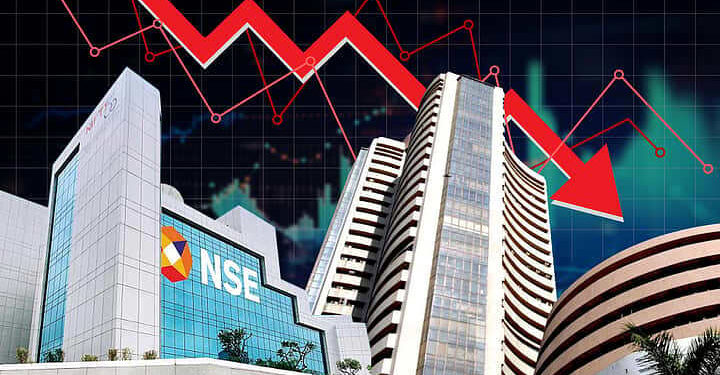
Sensex dropped 600 points: Indian stock markets witnessed a sharp sell-off on Thursday as Sensex dropped 600 points and Nifty fell 180 points following the implementation of additional US tariffs on Indian goods. The move, announced earlier this month, came into effect on August 27, intensifying pressure on Indian equities.
At 9:17 am, the BSE Sensex was trading at 80,315, down over 600 points, while the Nifty 50 slipped to 24,583, down 180 points. Analysts described the fall as the sharpest single-day drop in three months, signaling heightened volatility and weak investor sentiment.
Why Did the Stock Market Crash?
Market experts pointed to five major factors behind the Sensex and Nifty decline:
1. Trump’s Tariff Shock
US President Donald Trump recently imposed an additional 25% tariff on Indian goods, taking the total duties to 50%. The decision, linked to India’s purchase of Russian oil, has rattled investor confidence. Analysts say the tariff move not only raises concerns about exports but also creates fears of retaliatory trade measures.
2. Heavy FII Outflows
Foreign Institutional Investors (FIIs) have been pulling out funds aggressively since July. In August alone, FIIs sold Indian stocks worth ₹34,733 crore in the cash segment, following withdrawals of ₹47,667 crore in July. Analysts believe the combination of high US interest rates, a stronger dollar, and trade tensions has accelerated FII exits.
3. Stretched Valuations and Weak Earnings
Market valuations remain elevated despite weak earnings growth. Experts caution that stretched price-to-earnings ratios make Indian equities vulnerable to corrections. “The real challenge for the markets is the mismatch between earnings and valuations. With FIIs exiting, domestic investors may not be able to fully cushion the fall,” said VK Vijayakumar, Chief Investment Strategist at Geojit Investments.
4. Economic Risks from Tariffs
While the direct impact of tariffs on India’s GDP may be moderate, the broader concern is a possible global economic slowdown. Trump’s aggressive trade stance could trigger ripple effects across Asia. For India, this may delay the long-awaited earnings revival in the second half of the year.
5. Technical Weakness in Nifty
On the technical charts, Nifty fell below 24,600, breaching key support levels. According to Reliance Securities, the index slipped under its 20-day simple moving average of 24,739, indicating near-term bearish momentum. Analysts see support around 24,500, with resistance levels capped near 25,000.
Sector-Wise Market Impact
Fourteen of the sixteen major sectors logged losses. Banking, IT, and auto stocks were among the biggest drags on the market, while only select pharma and FMCG counters showed resilience. Mid-caps and small-caps also slipped, though losses were less pronounced compared to blue-chip indices.
Analysts’ Outlook
Experts remain divided on the short-term outlook. Some predict further downside if US-India trade tensions escalate, while others see the correction as a buying opportunity for long-term investors.
“Investors should focus on large-cap stocks with strong domestic demand drivers. Overvalued small-caps may see deeper corrections,” said Amruta Shinde, Technical Analyst at Choice Equity Broking.
On the positive side, US Treasury Secretary Scott Bessent said on Wednesday that India and the US will “come together” to resolve the tariff dispute, raising hopes of eventual relief for markets.
What Should Investors Do?
Analysts suggest cautious positioning in the near term as Sensex and Nifty continue to face volatility. Key strategies include:
-
Shifting focus to defensive sectors like FMCG and pharma.
-
Avoiding aggressive bets on small-caps and highly leveraged firms.
-
Watching out for support levels around 24,200 on Nifty and 79,800 on Sensex.
-
Staying alert to global cues, particularly US-China and US-India trade developments.
Conclusion
The combined impact of US tariffs, FII outflows, stretched valuations, and global uncertainties has led to one of the sharpest market corrections in months, with Sensex and Nifty bearing the brunt of the decline. While long-term fundamentals of the Indian economy remain intact, investors may need to brace for volatility in the coming weeks. Much now depends on the outcome of trade talks between New Delhi and Washington.














